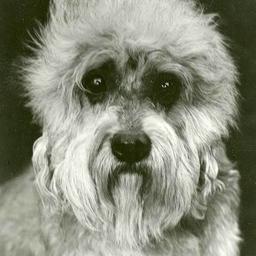Dandie Dinmont Terrier
Although these dogs have been around for a few centuries, they were not known outside of their Scottish border regions until the early 19th century.

Height
8-11 in.
Weight
18-24 lbs
Life Expectancy
12-15 yrs.
History of the Dandie Dinmont Terrier
The breed originates from the dogs being used in the Anglo-Scottish border country. During the 1600s, they were used for hunting badgers and otters. Whilst their ultimate origin remains unknown, dogs owned by the Allans of Holystone, Northumberland in the early 1700s are thought to have been involved in their early origins.
Read more: wikipedia

Characteristics of the Dandie Dinmont Terrier
The Dandie Dinmont Terrier is a playful, affectionate small breed. These dogs make great family pets or travel companions, and they enjoy spending time with their human family.
Energy Level
Exercise Requirements
Playfulness
Affection Level
Friendliness Dogs
Friendliness Pets
Friendliness Strangers
Watchfulness
Trainability
Grooming Requirements
Heat Sensitivity
Vocality
Dandie Dinmont Terrier Care
The Dandie Dinmont's small size and calm temperament make it one of the easiest breeds to care for when it comes to exercise. However, they require specific grooming to maintain their coats, as well as persistent training.
Exercise
Dandie Dinmonts require low-to-moderate exercise. They can thrive in smaller spaces, like apartments, as well as larger houses with yards. Walk your Dandie Dinmont for a few minutes each day, or play for 20 to 30 minutes, to keep them fit. It is crucial to remember that these dogs should never be allowed off-leash in an unfenced area. They have a strong prey drive, so they're likely to chase after birds, squirrels, and other animals if given the opportunity.
Grooming
Dandie Dinmonts are working dogs, and their coats require regular maintenance. You must clip their coats with scissors every four to six weeks to maintain their unique shape and appearance. Brush your Dandie Dinmont several times a week with a soft brush to remove any mats or tangles. This breed's coat is more high-maintenance than other terriers, but their low-shedding nature is ideal for owners with allergies. It also reduces the need to vacuum pet hair.
Training
Training a Dandie Dinmont terrier requires persistence and patience, just like with other terriers. These dogs are highly intelligent, so it is important to keep them engaged and stimulated. Keep training engaging and interesting by incorporating playtime and challenges for your dog. Dandie Dinmonts are also prone to digging, so it's essential to train against this habit or create a designated digging area in your yard.
Dandie Dinmont Terriers are highly intelligent, lower-energy terriers that are adaptable to their surroundings. Be prepared to be hands-on during obedience training and expect to find holes in your backyard. Dandie Dinmont Terriers may be the "gentlemen" of the group, but they're also terriers through and through.
Nutrition
The Dandie Dinmont should be fed a high-quality dog food appropriate to the dog's age (puppy, adult, or senior). Some dogs are prone to getting overweight, so keep an eye on your dog's calorie consumption and weight level. Treats can be an important aid in training, but too many can cause obesity. Do not give table scraps, especially cooked bones and foods with high fat content. Learn which human foods are safe for dogs and which are not. If you have any concerns about your dog's weight or diet, consult your vet.
Health Problems
As with other purebreds, Dandie Dinmonts are susceptible to certain health concerns. Responsible breeders take steps to reduce their litters' risk of developing health problems, but your dog may experience these common conditions:
Intervertebral Disc Disease (IVDD): Dandie Dinmonts have elongated bodies, which makes them more susceptible to spinal injuries and diseases like IVDD, which affects the discs in your dog's spine. Dandie Dinmonts should avoid jumping off high surfaces, and family members should practice care when picking them up.
Glaucoma: This condition is caused by pressure on the eye, which will eventually lead to blindness. If your Dandie Dinmont is squinting, rubbing, or tearing its eye, contact your vet immediately to begin treatment.
Cheyletiella Yasguri Mites (Cheyletiellosis): All dog breeds can contract Cheyletiella yasguri mites, and Dandie Dinmonts are reportedly more susceptible. If you see red, scaly, itchy skin and mites on your dog's skin or coat, you need to take action.
Pros
- Intelligent
- Doesn't bark much
- Very strong
Cons
- Stubborn
- Loud bark
- Hard to find
Did You Know?
Queen Victoria owned and loved a Dandie.
Dandie Dinmonts were first recorded as a distinct breed around 1700.
Dandie Dinmont Terriers are small, calm dogs that are adaptable to a variety of lifestyles.

